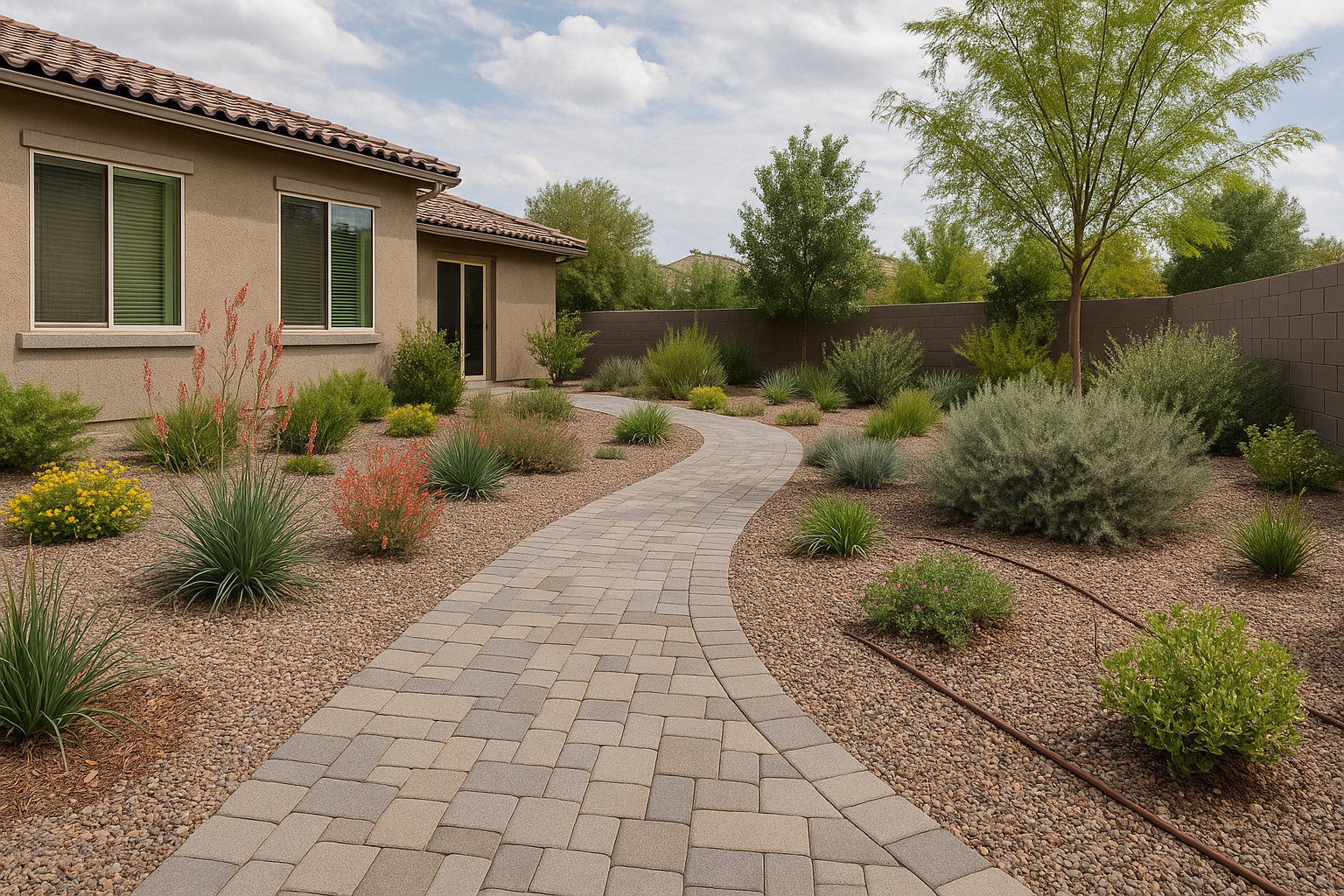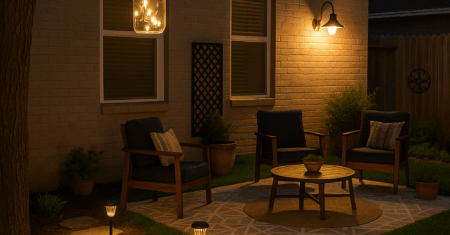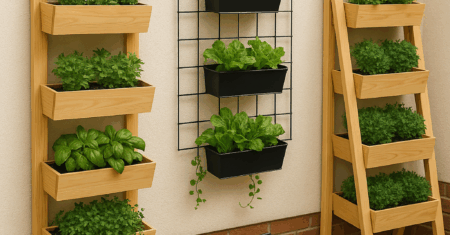Transform Your Outdoor Space: The Green Man Landscaping Method for Sustainable, Low-Maintenance Gardens

Have you ever looked at your outdoor space with a mixture of disappointment and overwhelm, wondering how to create a beautiful garden that doesn’t demand constant attention? Many homeowners struggle with this exact challenge – wanting a stunning landscape that enhances their property without becoming a second job. The Green Man Landscaping Method offers a revolutionary approach to this common dilemma, combining ecological wisdom with practical design strategies. Drawing from over two decades of transforming neglected yards into thriving ecosystems, this system has helped thousands of homeowners achieve the outdoor spaces they desire with a fraction of the typical maintenance requirements. It’s time to stop fighting against nature and start working with it to create the sustainable, low-maintenance garden you’ve always wanted.
🌿 What You’ll Discover About The Green Man Landscaping Method
- 🌱 Work With Nature – How to assess your specific site conditions and select the perfect plants
- 💧 Water-Wise Design – Techniques to reduce irrigation needs by up to 70%
- 🔄 Sustainable Systems – Creating self-maintaining ecological relationships in your landscape
- 🏡 Beautiful Hardscaping – Low-maintenance structural elements that enhance usability
- 🌟 Year-Round Appeal – Strategies for gardens that look spectacular across all seasons
Understanding Your Site: The Foundation of Success
Before rushing to select plants or design features, the Green Man Landscaping Method begins with a comprehensive understanding of your unique site. This critical first step is often overlooked, yet according to the American Society of Landscape Architects, it’s responsible for up to 80% of landscape failure when skipped or performed inadequately.
“Most homeowners jump straight to plant selection based on aesthetics alone, which is like choosing clothes without considering the weather,” explains Maria Rodriguez, founder of Green Man Landscaping. “Our method starts with understanding what nature is already trying to do on your property—the soil conditions, water patterns, sun exposure, and existing plant communities. This information becomes your roadmap to success.”
A proper site analysis doesn’t just prevent future problems; it reveals hidden opportunities unique to your property. That troublesome soggy area could transform into a thriving rain garden. The scorching south-facing slope might become a Mediterranean herb garden. By working with your site’s natural characteristics instead of fighting against them, you’ll save countless hours of maintenance and significantly reduce resource inputs like water, fertilizer, and labor.
The Five Core Principles of Green Man Landscaping
The Green Man Landscaping Method stands on five interconnected principles that work together to create gardens that thrive with minimal intervention. Each principle builds upon the others to create a holistic approach to landscape design and maintenance.
- Right Plant, Right Place – Select plants based on your specific site conditions rather than forcing plants to adapt to unsuitable environments
- Water Efficiency by Design – Incorporate strategies like hydrozoning, smart irrigation, and rainfall harvesting to minimize water usage
- Living Soil Systems – Build and maintain healthy soil biology that supports plant health naturally without synthetic inputs
- Functional Hardscaping – Integrate durable, low-maintenance structural elements that enhance usability while reducing maintenance areas
- Ecological Relationships – Foster beneficial interactions between plants, wildlife, and microorganisms to create self-sustaining systems
A study by the University of Washington found that landscapes designed with these ecological principles required 60% less maintenance time and 70% less water than conventional landscapes after the establishment period.
Pro Tip: Begin implementing these principles in one defined area rather than attempting to transform your entire property at once. This “keystone area” approach allows you to learn through experience and gradually expand your sustainable landscape as your confidence grows.
The beauty of this method is its adaptability to different aesthetic preferences—whether you prefer a formal garden look, a naturalistic meadow, or something in between, these principles provide the framework for success.
Planning Your Landscape: Creating Functional Outdoor Spaces
Effective landscape planning goes beyond aesthetics to create outdoor spaces that enhance your lifestyle while minimizing maintenance requirements. The Green Man Landscaping Method approaches this through a systematic “outdoor room” concept.
Outdoor Room Planning by Maintenance Level

This zoning approach focuses your efforts where they matter most—the spaces you actively use and see daily. As landscape architect Sarah Jensen notes, “By designating 60-70% of your yard as low-maintenance habitat, you free up time to enjoy and maintain the 30-40% you actually use regularly.”
The planning process should also consider flow between spaces, visual connections from key viewpoints (especially windows), and seasonal changes. Using digital tools like the Green Man Landscaping Planner app can help visualize these relationships before breaking ground.
For deeper exploration of sustainable landscape planning principles, see our article on Creating Outdoor Rooms with Native Plants.
Plant Selection Strategy: The Heart of Low-Maintenance Gardens
Selecting the right plants is perhaps the most critical decision in creating truly sustainable landscapes. The Green Man Landscaping Method uses a tiered approach that prioritizes plants requiring minimal intervention while creating maximum beauty and ecological value.
Green Man Plant Selection Hierarchy
- Regional Native Plants (40-60% of selections)
- Naturally adapted to local conditions
- Support local wildlife and pollinators
- Require minimal water once established
- Examples: Echinacea, Little Bluestem, Oak-Leaf Hydrangea
- Climate-Adapted Non-Natives (20-30%)
- Well-suited to your specific conditions
- Not invasive in your region
- Drought-tolerant after establishment
- Examples: Lavender, Russian Sage, Sedum
- Food-Producing Plants (10-20%)
- Integrated into ornamental areas
- Focus on perennial and self-seeding varieties
- Examples: Blueberries, Herbs, Alpine Strawberries
- Special Interest Plants (5-10%)
- Higher maintenance “focal point” plants
- Used sparingly in high-visibility areas
- Examples: Japanese Maple, Specialty Roses, Unique Perennials
“This balanced approach creates resilient landscapes that don’t sacrifice beauty for functionality,” explains botanist Dr. James Wilson. “By reserving your higher-maintenance plants for key focal areas, you create visual impact while keeping the overall garden manageable.”
A real-world example comes from the Jensen family in Portland, who reduced their garden maintenance by 75% after redesigning with this plant selection strategy. “We used to spend every weekend maintaining our garden,” shares homeowner Michael Jensen. “Now we enjoy it instead of constantly working on it.”
Smart Hardscaping: Beautiful Structure with Minimal Upkeep
🏗️ Hardscaping elements form the permanent backbone of your landscape, defining spaces and providing functionality year-round. When designed thoughtfully, these features dramatically reduce maintenance while enhancing your outdoor living experience.
The Green Man Landscaping Method emphasizes these hardscape principles:
- 🌊 Permeable Surfaces – Allow water infiltration rather than runoff
- 🧱 Quality Materials – Invest in durability to minimize replacement
- 🌿 Plant Integration – Design hardscape with planting spaces
- 🧰 Simplified Maintenance – Eliminate narrow strips that are difficult to maintain
According to the Landscape Architecture Foundation, properly designed hardscaping can reduce overall landscape maintenance by 30-40% while increasing property values by 15-20%.
⚠️ Important: Always check local regulations before installing hardscape features. Many municipalities offer incentives for permeable paving options but may require permits for retaining walls over certain heights or extensive patio installations.
Consider these low-maintenance hardscape options for different garden areas:
- Pathways: Flagstone with thyme joints, decomposed granite, or permeable pavers
- Entertaining Areas: Mortared stone, porcelain pavers, or composite decking
- Borders/Edges: Steel edging, natural stone borders, or buried concrete curbing
- Slopes: Dry-stacked stone walls, boulder terracing, or planted retaining systems
Choose materials that complement your home’s architecture while providing the durability needed for your specific climate conditions.
Water Management: Creating Resilient, Drought-Resistant Gardens
Effective water management stands at the core of the Green Man Landscaping Method, allowing gardens to thrive with minimal supplemental irrigation. By working with natural water patterns rather than against them, you can create landscapes that remain beautiful during both wet and dry periods.
Comparing Traditional vs. Green Man Water Management

Research from the EPA indicates that implementing these integrated water management strategies can reduce outdoor water use by up to 75% compared to conventional landscapes.
The Green Man approach views water challenges as opportunities: that soggy area becomes a rain garden featuring moisture-loving natives; the dry slope transforms into a Mediterranean herb garden; roof runoff feeds attractive rain barrels that irrigate nearby vegetables.
“One of the most effective strategies is hydrozoning—grouping plants with similar water needs together,” explains irrigation specialist Thomas Ramirez. “This simple approach prevents both overwatering and underwatering by allowing you to tailor irrigation precisely to each area’s requirements.”
For detailed guidance on implementing water-wise principles in your specific region, explore our companion article on Regional Water Conservation Techniques.
The Minimal Maintenance Calendar: Seasonal Care Made Simple
📅 Even the most thoughtfully designed landscapes require some maintenance, but the Green Man Landscaping Method streamlines these tasks into an efficient seasonal rhythm. By focusing on the right tasks at the right times, you’ll maximize results while minimizing effort.
Essential Seasonal Maintenance Checklist
- Early Spring (March-April)
- ✅ Cut back ornamental grasses and perennial stalks left for winter interest
- ✅ Apply compost topdressing to planting beds (½ inch layer)
- ✅ Edge beds and refresh mulch only where needed
- ✅ Prune summer/fall-blooming shrubs before new growth
- Late Spring (May-June)
- ✅ Remove spent spring bulb foliage after it yellows
- ✅ Hand pull weeds while soil is moist
- ✅ Check and adjust irrigation systems
- ✅ Prune spring-flowering shrubs after blooming
- Summer (July-August)
- ✅ Deadhead select perennials for extended blooming
- ✅ Spot-check irrigation during dry periods
- ✅ Light pruning of wayward growth
- ✅ Monitor for pest/disease issues
- Fall (September-November)
- ✅ Leave perennial seedheads for winter interest and wildlife
- ✅ Plant trees, shrubs and spring bulbs
- ✅ Reduce irrigation as temperatures cool
- ✅ Collect leaves for composting or use as mulch
- Winter (December-February)
- ✅ Enjoy structural elements and winter interest features
- ✅ Plan additions or modifications for spring
- ✅ Prune deciduous trees (except spring bloomers)
- ✅ Clean and sharpen tools
“Traditional landscapes often require weekend-consuming maintenance nearly year-round,” notes landscape maintenance expert Elena Park. “Our clients who implement the Green Man approach typically spend just 4-8 hours per month during the growing season, with many winter months requiring virtually no maintenance at all.”
For those with busy schedules, prioritizing these essential tasks ensures your garden remains healthy and attractive with minimal time investment. The secret is consistency with these focused efforts rather than sporadic intensive interventions.
Implementation: Your Journey to a Transformed Landscape
Transforming your outdoor space using the Green Man Landscaping Method is best approached as a phased journey rather than an overnight makeover. This systematic approach makes the process manageable both physically and financially while allowing ecological systems to develop naturally.
The Four Phases of Green Man Landscape Transformation
Phase 1: Assessment & Design (1-3 months)
- Complete site analysis (soil, sun, water patterns)
- Set priorities and create master plan
- Develop budget and timeline
- Consider professional design consultation
Phase 2: Foundation Development (2-6 months)
- Address structural issues (drainage, grade)
- Install key hardscaping elements
- Prepare soil properly in planting areas
- Establish irrigation infrastructure if needed
Phase 3: Core Planting (3-12 months)
- Install “anchor” trees and shrubs
- Add foundational perennials in groups
- Focus on establishing key areas first
- Allow plants to establish before expanding
Phase 4: Refinement & Evolution (Ongoing)
- Add seasonal interest plants
- Monitor and adjust as needed
- Incorporate learning from early phases
- Gradually expand successful approaches
“The phased approach allows you to learn as you go, making adjustments based on how plants perform in your specific conditions,” explains landscape designer Rebecca Moren. “It’s more forgiving and ultimately more successful than trying to do everything at once.”
The Green Man Landscaping transformation of the Hernandez family’s property in Colorado demonstrates this approach perfectly. “We started with just our front yard the first year,” shares homeowner Carmen Hernandez. “Once we saw how well those plants thrived with minimal care, we had the confidence to transform our backyard the following season, incorporating everything we’d learned.”
Frequently Asked Questions About Green Man Landscaping
🌿 How long does it take to see results with the Green Man Landscaping Method?
The Green Man Landscaping Method follows nature’s timeline: some results appear immediately, while others develop over time. Hardscaping elements provide instant structure, and properly selected mature plants offer immediate visual impact. However, the true beauty of this approach emerges in years 2-3 as plants establish deep root systems and begin to form natural communities. As landscape architect Diana Chen explains, “The first year they sleep, the second year they creep, and the third year they leap.” This patience pays tremendous dividends—by year three, maintenance requirements often drop by 70-80% compared to conventional landscaping.
💰 Is sustainable landscaping more expensive than traditional approaches?
While the initial investment in quality hardscaping materials and appropriate plants may be comparable to or slightly higher than conventional landscaping, the long-term economics strongly favor the Green Man approach. University of California research found that sustainable landscapes cost 60% less to maintain over a 10-year period compared to traditional landscapes. Water bills typically decrease 50-70%, plants require replacement far less frequently, and fewer inputs (fertilizers, pesticides, equipment) are needed. Many homeowners also report significant savings on professional maintenance services—often $2,000-5,000 annually.
🌱 Can I convert my existing landscape gradually, or do I need to start from scratch?
The Green Man Landscaping Method works exceptionally well for gradual conversions—in fact, this is the recommended approach for most homeowners. Begin by identifying a “keystone area” that’s highly visible or problematic (often the front yard or an area visible from main windows). Apply the Green Man principles to this area first, then gradually expand to other zones as time and budget allow. Existing plants can often be relocated to more appropriate locations based on their needs, reducing waste and preserving mature specimens that provide immediate impact in your new design.
🏡 Will a sustainable landscape look too “wild” for my neighborhood?
Sustainable landscapes using the Green Man method can range from highly structured formal designs to more naturalistic styles—the ecological principles work with any aesthetic preference. For more traditional neighborhoods, emphasize clean edges around planting beds, incorporate formal hedges as transition elements, and focus on neatly structured plantings near the home and street. These designed cues of human intention help neighbors appreciate your sustainable choices. Many Green Man landscapes win neighborhood beautification awards precisely because they combine ecological wisdom with beautiful design principles.
🔧 Do I need special skills or equipment to maintain a Green Man landscape?
One of the core benefits of the Green Man approach is that it significantly reduces the need for specialized equipment and technical skills. Basic tools like pruners, a weeding knife, and a rake handle nearly all maintenance tasks. The emphasis on right plant, right place means less intervention is needed to keep plants healthy. The most important skill is observation—learning to spot small issues before they become problems. For those who enjoy technology, smart irrigation controllers and soil moisture sensors can further streamline the minimal maintenance required.
🦋 How do I attract beneficial wildlife without also attracting pests?
Creating ecological balance is key to the Green Man approach. By focusing on structural diversity (plants of different heights and types) and native species, you naturally attract beneficial insects and birds that help control potential pest species. Strategic plant selection also helps—for example, incorporating aromatic herbs like rosemary and lavender naturally repels many unwanted insects while attracting pollinators. If specific pest issues arise, the Green Man method emphasizes targeted biological controls rather than broad-spectrum treatments that disrupt the beneficial relationships you’re building.
Explore Our Related Articles:
- Native Plant Selection: The Green Man Landscaping Approach to Biodiversity
- Water-Wise Garden Design: Green Man Landscaping Solutions for Drought-Prone Areas
- Low-Maintenance Perennials Recommended by Green Man Landscaping Designers
- Smart Hardscaping: Green Man Landscaping’s Guide to Beautiful, Maintenance-Free Features
Recommended Books:
- Planting in a Post-Wild World by Thomas Rainer and Claudia West
- The Living Landscape by Rick Darke and Doug Tallamy
- Drought-Resistant Landscaping by Jennifer Bennett
- The Green Garden Designer by Ethne Clarke
What aspect of the Green Man Landscaping Method are you most excited to implement in your outdoor space? Share your plans in the comments below, or tag us in your transformation photos on social media with #GreenManLandscaping!




0 Comments